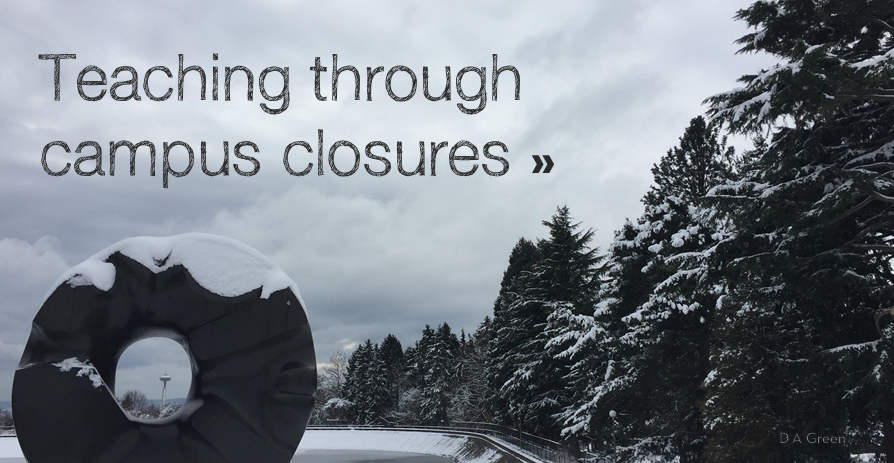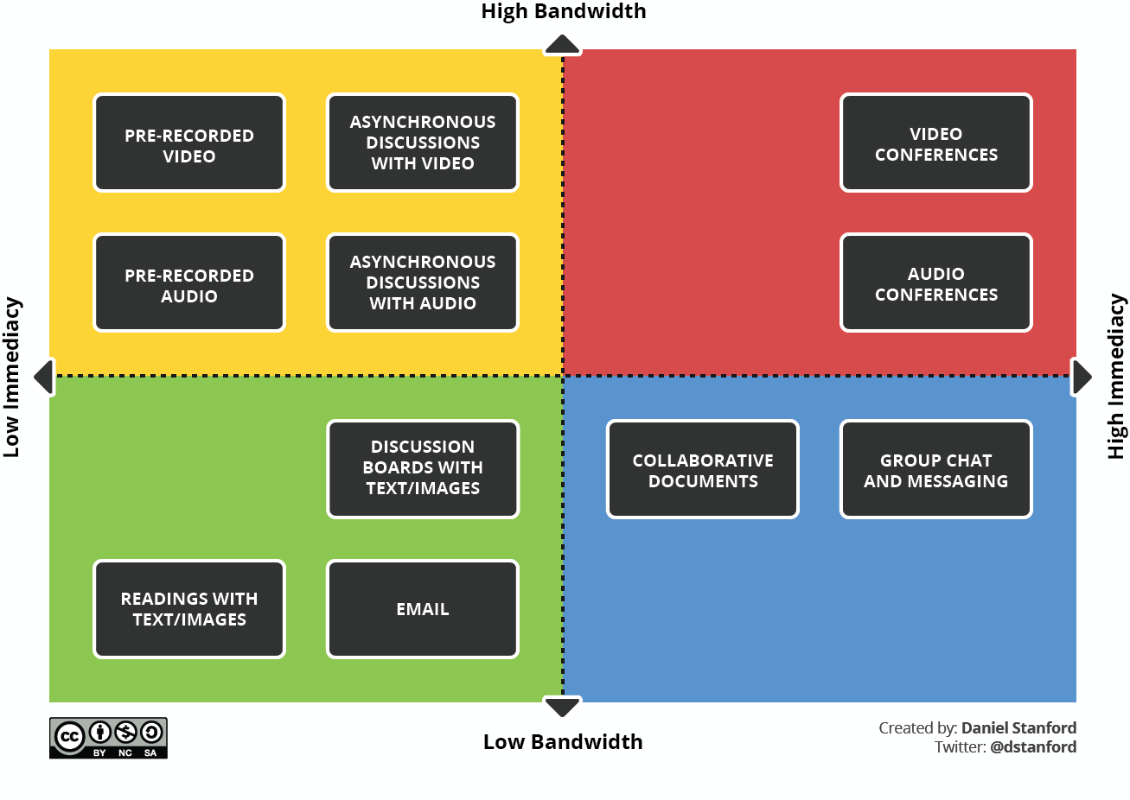
Teaching through campus closures

- Download this page as a PDF: Teaching through campus closures
General preparedness for disrupted classes or campus closures
Often Seattle University escapes the academic year without a single campus closure. But the occasional snow day in fall or winter does happen – as do power outages – and can raise faculty and student anxiety about the syllabus and assignments.
March 2020 – COVID-19
You may also find the advice here relevant in the light of the COVID-19 campus closure; here, mentally replace "power outages" with the other kinds of factors that may affect our students: potential care-giving responsibilities, lack of quiet space, uneven access to online materials, low bandwidth, as well as general anxiety around a global pandemic.
This page is here to provide some preemptive and in-the-moment advice and recommendations on how best to respond to campus closures. Remember that if power outages occur, our online solutions are moot, so think about both technology-infused and technology-free options.
In thinking about the technological options available to you, you might find Daniel Stanford's Bandwidth–Immediacy matrix helpful.

The following advice is divided into three sections, based on timing:
-
In-the-moment: Advice for when you need a back-up plan *now*
-
After-the-moment: Catching up on course content once campus reopens
-
Preemptive: General advice for the course planning process – ready for next time!
David A Green, PhD | Winter 2019/Winter-Spring 2020
In-the-moment
Advice for when you need a back-up plan *now*
-
Overview
-
Campus closures will likely mean that you cannot deliver the course exactly as originally intended. However you decide to respond to campus closures, we strongly recommend you focus on promoting deep learning. This is best done by covering fewer topics, but in depth, rather than trying to cover all topics, but superficially. Students are far more likely to retain and be able to use their new knowledge from the course if you have encouraged a deep approach.
If you’ve not had chance to plan for campus closures in advance, then try these ideas, partly adapted from Tufts University’s teaching center, and partly from our own Just-in-Time Teaching workshop, which was ironically cancelled for February 11, 2019 – due to snow.
-
Communicate with your students
-
Let your students know straight away that they will still be expected to progress with their work. Ideally, you’ll be able to tell them this in class, but if not, then use the regular communication channel you have used to communicate them (whether by email or through Canvas).
-
Gauge workload
-
Work out what level of work is reasonable at short notice – presuming that students will have power. (If there are outages, then do not expect that students will reasonably be able to complete even readings. Daylight hours may well not be free to read due to more pressing essentials.)
Replacement individual work
Set additional readings, assignments, online quizzes (graded or ungraded), reflection papers (complete/incomplete), or short projects for students to complete instead of class.
Replacement online learning
See notes below under “Technological preparation.” A few suggestions:
- Use Canvas to share text, audio, or video files.
- Create short open-ended or multiple-choice quizzes in Canvas based on the readings. (Note that MCQs are hard to write and so short-answer questions may be more time-efficient for you.)
- Use Arc in Canvas to record short (max. 5–7-minute) videos on the students’ sticking points based on their quiz responses. Try not to be too scripted here – students learn better from videos that are less formal and use more natural speech.
- Use Discussions in Canvas for students to communicate with each other and with you, either in small groups or together.
- If a tool isn’t working for your students’ learning, stop using it and try something else. Communicate to students that this is what you are doing and mention why.
- Be cautious of using synchronous tech for the first time: If you haven’t had time to do a “dry run” with your students using synchronous conferencing tools in this course (see final section of this page), then stick with asynchronous tools or low-/no-tech solutions. (Just think of your first group Skype or Zoom meetings and how much time is lost to people struggling to get their camera or mic to work. Now multiply that to match your class size and add the anxiety of impending assignment deadlines.) Using conferencing tools with technologically unprepared students will put them at a disadvantage.
After-the-moment
Catching up on course content once campus reopens
-
Re-calibrate your course
-
Even if you had done a lot of preparation (as suggested in the “preemptive” section below), you may well have to adjust the syllabus and play catch-up. Importantly, it will still need to be in a digestible form for students so that it maximizes their learning without creating undue anxiety; student anxiety will lead to poorer performance and disappointing results, so try these suggestions instead.
Remove the "could knows" to keep room for the "must knows"
Take out those “non-essential classes” (“could knows” or “should knows”) that don’t directly lead to student assignments (“must knows”) so that students are still covering all the core material. Remember to communicate to students that those topics are intentionally built-in to allow flexibility.
Choose depth over breadth
If you find it difficult to work out what might be non-essential, then focus on depth over breadth. For instance, consider what skills students are developing in each of the classes. Which of those skills (whether intellectual, analytical, practical, interpersonal, etc.) overlap between classes, or are slight extensions of skills the students have already been developing, but applied to a new topic area? Once you have identified those overlaps, you can take out one of the topics, focus on the skill development and go deep in that area.
-
Review assignments
-
Push back assignment deadlines slightly – with student consent
For assignments that are due during or shortly after the time of a campus closure, consider moving them back so that you are able to cover key material together before students complete the assignments. ALL changes to assignment deadlines are best exercised by class vote. Having overall class consent (e.g. 50% or more in favor), rather than imposing a change (even when that change is designed to help students’ learning) maintains a much better class atmosphere.
Again, revise assignments to focus on depth, not breadth
Consider adjusting upcoming assignments so that they focus on the areas that remain in your revised syllabus and so that students will have had chance to process those ideas together in class. Decrease the content, but not the rigor: Rather than simplifying the task into something that will be less intellectually challenging or might be dull for the students to complete, trying narrowing the area of focus so that students can still demonstrate depth and really feel they have been learning.
Pre-emptive
General advice for the course planning process – for next time!
-
Revise your syllabus
-
Map out the syllabus in detail
The better laid out your session-by-session schedule is in your syllabus, the easier it will be to see the big picture and adjust. Consider including for each session: (1) the preparation students need to complete before class; (2) any assignments that are due in class; (3) the overarching topic(s) of the day’s class. (See the end of our syllabus template.)
Build space into the syllabus
Where possible, build in one or even two class sessions where the content that students will be exploring in class is NOT absolutely essential for them to be able to complete their assignments successfully. If you then find you need to rearrange the schedule, those “non-essential” classes could be removed without negatively impacting learning.
Communicate
Consider including a short statement in your syllabus on “instructional continuity” or “how we keep on track even if it’s snowing out” so that students are aware that you have plans at the ready.
-
Prepare to use technology
-
Use Canvas
Have a well-structured Canvas site mirroring your syllabus to support learning in your course. This will allow you flexibility once the quarter/semester is underway without feeling that you are starting from scratch. We suggest you take CDLI’s online/hybrid course design course. Also check out CDLI’s Faculty Help page for Canvas.
Gadget Finder
Use CDLI’s great Gadget Finder to locate the tools that will best meet your learning goals for your students.
Be flexible
If a tool isn’t working for your students’ learning, stop using it and try something else. Communicate to students that this is what you are doing and mention why.
-
Consider individual class sessions
-
Learning goals
When planning a class, work out what learning goals you are trying to reach in that class, and then select appropriate learning activities for students to complete together, whether that be face-to-face, online, or a combination of the two.
“Shadow” course development
If your course is designed to be face-to-face only, consider starting to create a “shadow” course plan of alternative online ways to reach the same learning goals, and then each year, designing one or two of these as a backup.
Training for learning technologies
When designing “shadow classes,” check whether you need any training on learning technologies and consult with our colleagues over at CDLI.
Additional readings
If you are looking for low-tech or no-tech solutions to potential campus closures, create a prioritized list of potential additional readings that will help students work toward the learning goals of the class. Ask students to write short reflection papers on the readings or to answer specific questions on them (geared toward your learning goals for that class), and assign those reflections a few points toward the course grade; so as not to overload you with grading when campus reopens, consider grading them as complete/incomplete, or as good/adequate/incomplete so that you don’t have to grade any finer than two or three categories of performance.
Be cautious of using synchronous tech for the first time
If you haven’t had time to do a “dry run” with your students using synchronous conferencing tools in this course (see next section), then stick with asynchronous tools or low-/no-tech solutions. Using conferencing tools with technologically unprepared students will put them at a disadvantage.
-
Practice with "dress rehearsals"
-
Solo practice
Practice using any new technology yourself (without the students) so that you’re ready to help students if they encounter problems.
Group practice
Try testing out one “alternative” format early in each course with your students so that you get their feedback on what worked for their learning and can make adjustments. It also means that if you have a real campus closure, everyone will be more confident that they can cope with a different format.
David A Green, PhD | Winter 2019